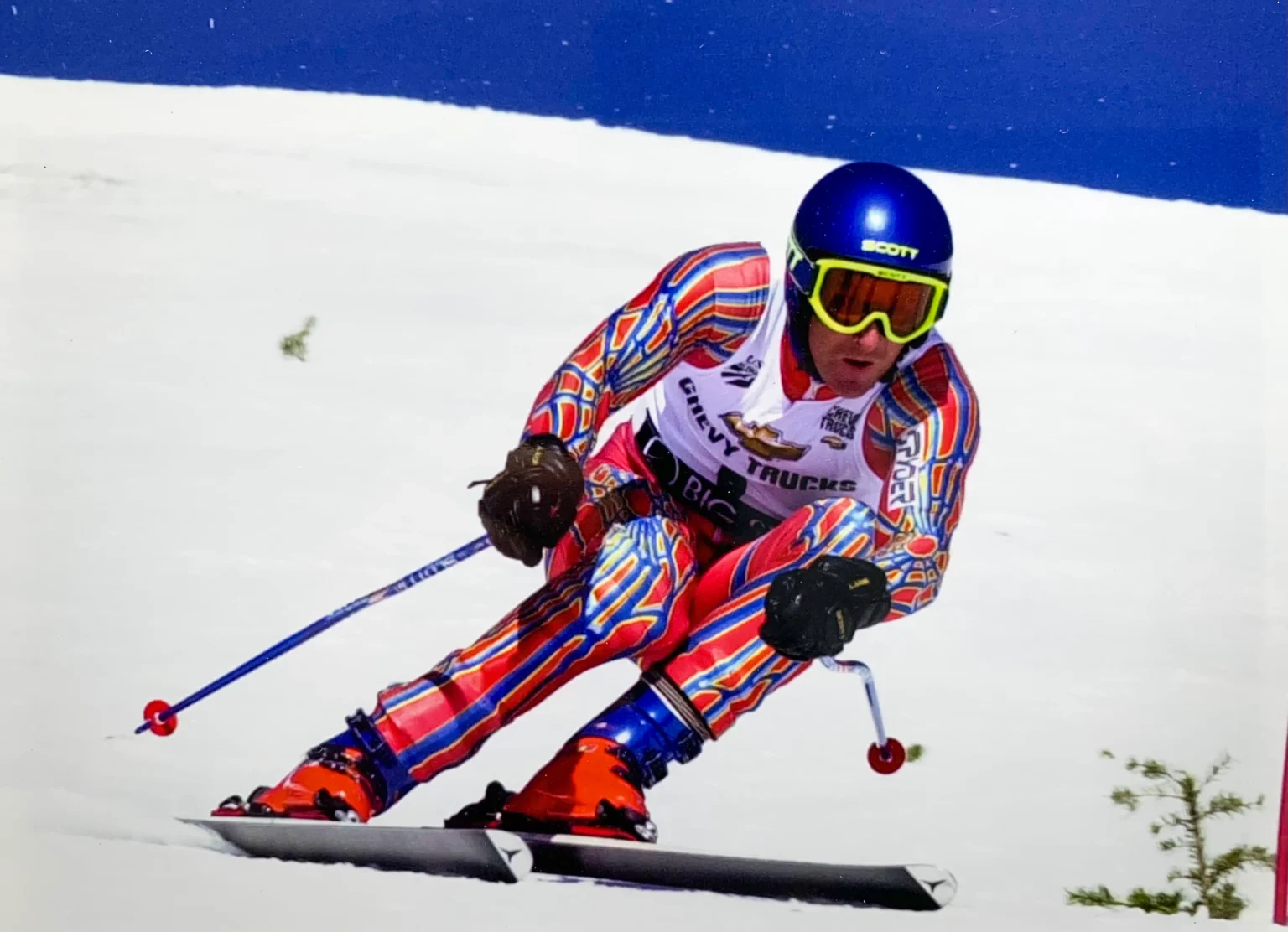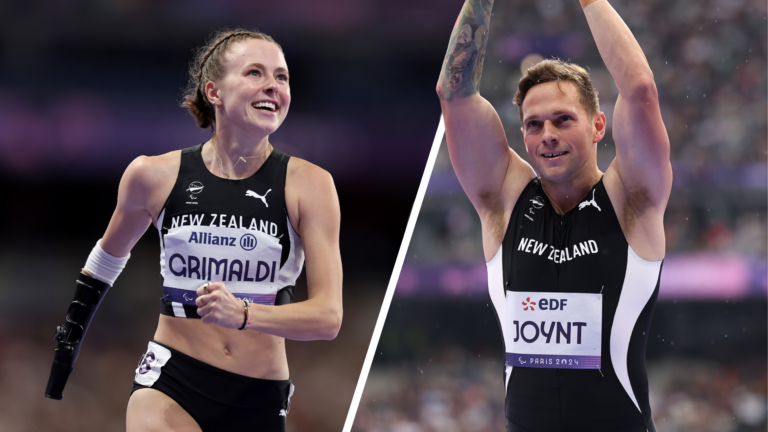In the latest of our series focusing on Paralympic Winter Sport legends, we put the spotlight on four-time Paralympic Games medallist Paralympian #115 Steven Bayley.
Competing in conditions more closely akin to that experienced at Mount Olympus Ski Field, the greatest moment of Steven Bayley’s Para alpine ski career came winning Giant Slalom LW4 gold at the Salt Lake City 2002 Paralympic Games.
Having grown up skiing with his family on the club ski field in the Craigieburn Range – which regularly provided challenging conditions – when on the day of the Giant Slalom at Salt Lake City 2002 was met by a dump of snow, gusty winds and a bumpy course, he remained unfazed.
“To be honest, the day was terrible and provided marginal racing conditions,” recalls Steven, 53. “It added a number of factors to the racing for not only me but the rest of the field. Having often faced those conditions at Mount Olympus favoured me.”
His instincts proved right as he produced two of the best runs of his career to storm to victory by a huge margin of more than two seconds. Pocketing a Paralympic Games gold medal was a dream come true and was barely comprehensible at the time to a shellshocked Steven.

“It was phenomenal, surreal and hard to fathom,” he reflects. “I didn’t allow myself to celebrate because I was thinking, is this happening? Then you start to process what is happening. You step on the podium, listen to the national anthem and at that time you feel like you are in slow motion. It was the peak moment in my journey.”
Raised in Christchurch, Steven and his family had a long-time connection to skiing. His grandfather set up the Mount Olympus Ski Field and is one of its founding members. His parents spent a lot of time on the club field and each winter the Cantabrian would spend one to two weeks on the mountain.
“I grew up on the snow at Mount Olympus,” he recalls. “Back then I wore leather boots with wooden skis, screw on steel edges and leather binding straps. It was basic equipment, but I just loved hanging out with the other kids on the snow.”
His passion for skiing remained during his adult years and it was while working as a lift operator at the Porters Ski Field in 1994, which was to change the course of his life. Driving back into town a wheel fell off his car. Losing control, Steven hit a power pole with the impact ripping his foot in half.
“The three other people in the car were uninjured,” adds Steven who was aged 24 at the time. “It was one of those freak accidents.”
In hospital he was shown an X-ray of his foot and was told amputation was the only option. Yet rather than feel sorry for himself he told his mother while in bed recovering “now I can ski at the Paralympics.”
Some eight months later and visiting friends at Porter Ski Field he found out more about Para Alpine skiing and in 1996 he competed in his first national championship in Wanaka. Sufficiently impressing, he advanced to the New Zealand development team and so began his Para sport journey.

Fitted with a prostheses on his foot, Steven was a Para alpine skiier on a “path of discovery” and he leapt at the opportunities.
“It was rewarding and validating to meet other people who were overcoming far greater disabilities than I had,” he recalls. “I loved being back on snow making friends and enjoying the camaraderie. It reaffirmed to me I was on the right path.”
On snow “five or six times a week” he worked hard to hone his technique. He competed in the US and later on the World Cup circuit making gradual physical and mental improvements.
Earning selection for the Nagano 1998 Paralympic Games he glows with pride at the achievement.
“It was phenomenal to be selected, and the process of travelling to the Games and being part of it was mind-blowing,” says Steven. “One of the highlights was walking into the stadium at the Opening Ceremony with 30,000 people cheering, just like I’d seen at Olympic Games ceremonies. I have so many positive memories of being in Japan and experiencing a different culture.”

Making his Paralympic Games debut he arrived with few expectations but exceeded them by winning a bronze medal in the Men’s Giant Slalom LW4.
“I knew I had an outside chance of a podium but because of that lack of experience and having only been racing for two years, I went in with an open mind,” says Steven, who also placed fourth in the Men’s Downhill LW4 and the Men’s Super-G LW4 at Nagano 1998.
“I was beautifully surprised by the result in the giant slalom,” he says. “I was over the moon to win bronze so early in my career.”
His medal-winning performance was given the attention it deserved on his return to Aotearoa New Zealand. He enjoyed a reception at Christchurch Airport, World Championship-winning triathlete Erin Baker presented Steven with a plaque, and he fulfilled numerous media engagements.
Nagano 1998 had offered Steven a taste of success but looking ahead to the Salt Lake City 2002 Paralympic Winter Games he wanted more.
“Winning a bronze medal in Nagano gave me a lot of confidence that I could achieve a gold medal in 2002,” he says.
Based in Winter Park during the Northern Hemisphere winter he continued to improve. In 1999 he was crowned Men’s Downhill LW4 World Cup champion and in 2000 he secured a silver medal in the Men’s Downhill LW4 at the World Ski Championships for the Disabled in Switzerland.
Leading into Salt Lake City 2002 he experienced one of his poorest ever seasons in Giant Slalom and he went in with “low expectations” in the event where he claimed bronze in Nagano 1998. However, his slalom had gone well, and he was relishing the prospect of competing in this event – the last on his four-race schedule in Salt Lake City 2002.
Making a successful start to his campaign in the speed events, he secured bronze medals in near perfect conditions in both the Men’s Downhill LW4 and Men’s Super-G LW4 events.
However, for the giant slalom the conditions deteriorated and ahead of his first of two runs he adopted a race tactic which was to prove critical to his subsequent gold medal success.
“During the inspection I noticed there was quite a slow, flat section before the course headed over this big roller into a steep pitch to the finish,” he explains. “I know this final section of eight to ten gates would catch a few people out, so I thought I’d be cautious and ski the slow, flat section a bit slower before setting myself up for the final pitch down the finish line. The other skiers ran straight through the flat section but when they hit that first gate on the pitch, they were late, skidding and sliding and they spent the next ten gates trying to recover.”
By contrast, Steven’s different tactical approach reaped rewards as he hit the finish line holding a half-a-second lead after the first run. Delighted to hold the advantage he then admitted he faced a big decision on how to approach the second run.
Should he opt for a conservative approach to protect his lead or be bolder? With fewer trickier gates on the second run – just seconds before he was due to head out of the start gate, he had a wave of clarity.
“The thought popped in my head to approach the second run just like I had the first run,” he explains. “I set off with a big yeeha and went hell for leather. I managed to ski the run of my life. By the time I hit the bottom of the course I was two seconds ahead having won the gold. I thought, what is going on?”
A DNF followed in the Men’s Slalom LW4 but nothing could sully his pride in becoming a Paralympic champion.
“Rapt” for his NZ Paralympic Team teammate Paralympian #114 Rachael Battersby, who claimed three gold medals at Salt Lake City 2002, the duo claimed a total of six medals between them and guided New Zealand to tenth in the medal table.
Having achieved his goal of winning a Paralympic Games gold medal he retired from competition post-Salt Lake City 2002. He settled in Christchurch and had three daughters – today aged 19, 17 and 15.

Now re-married and working for his own garden maintenance company, he volunteers for several organisations including Adaptive Snow Sports Canterbury, and he hopes in future to continue to give back more back to the sport of Para alpine skiing.
Yet whatever the future holds, his Para sport journey provided incalculable benefits.
“Losing my leg and moving into Para sport expanded my horizons,” he says. “It connected me with so many people and experiences that will be hard to match. It opened my perspective on how people overcome challenges and what is possible. It has been phenomenal.”
***Learn more about Para alpine skiing and how to get involved here



























